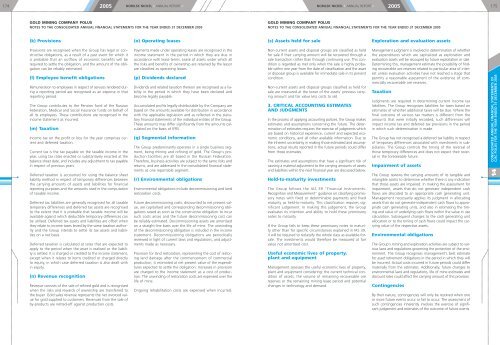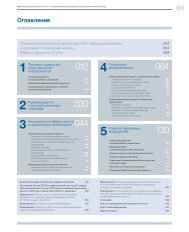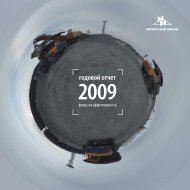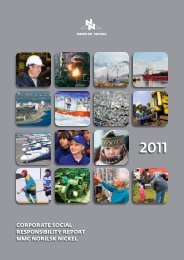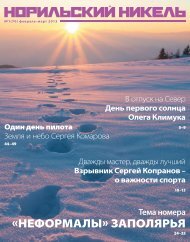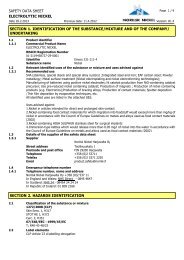Untitled - PRIME Gold
Untitled - PRIME Gold
Untitled - PRIME Gold
- No tags were found...
You also want an ePaper? Increase the reach of your titles
YUMPU automatically turns print PDFs into web optimized ePapers that Google loves.
1742005NORILSK NICKEL • ANNUAL REPORT •NORILSK NICKEL • ANNUAL REPORT •2005175GOLD MINING COMPANY POLUSNOTES TO THE CONSOLIDATED ANNUAL FINANCIAL STATEMENTS FOR THE YEAR ENDED 31 DECEMBER 2005GOLD MINING COMPANY POLUSNOTES TO THE CONSOLIDATED ANNUAL FINANCIAL STATEMENTS FOR THE YEAR ENDED 31 DECEMBER 2005(k) Provisions(o) Operating leases(s) Assets held for saleExploration and evaluation assetsProvisions are recognised when the Group has legal or constructiveobligations, as a result of a past event for which itis probable that an outflow of economic benefits will berequired to settle the obligation, and the amount of the obligationcan be reliably estimated(l) Employee benefit obligationsRemuneration to employees in respect of services rendered duringa reporting period are recognised as an expense in thatreporting period.The Group contributes to the Pension fund of the RussianFederation, Medical and Social Insurance funds on behalf ofall its employees. These contributions are recognised in theincome statement as incurred.(m) TaxationIncome tax on the profit or loss for the year comprises currentand deferred taxation.Current tax is the tax payable on the taxable income in theyear, using tax rates enacted or substantively enacted at thebalance sheet date, and includes any adjustment to tax payablein respect of previous years.Deferred taxation is accounted for using the balance sheetliability method in respect of temporary differences betweenthe carrying amounts of assets and liabilities for financialreporting purposes and the amounts used in the computationof taxable income.Deferred tax liabilities are generally recognised for all taxabletemporary differences and deferred tax assets are recognisedto the extent that it is probable that taxable income will beavailable against which deductible temporary differences canbe utilised. Deferred tax assets and liabilities are offset whenthey relate to income taxes levied by the same taxation authorityand the Group intends to settle its tax assets and liabilitieson a net basis.Deferred taxation is calculated at rates that are expected toapply to the period when the asset is realised or the liabilityis settled. It is charged or credited to the income statement,except when it relates to items credited or charged directlyto equity, in which case deferred taxation is also dealt within equity.(n) Revenue recognitionRevenue consists of the sale of refined gold and is recognisedwhen the risks and rewards of ownership are transferred tothe buyer. <strong>Gold</strong> sales revenue represents the net invoiced valuefor gold supplied to customers. Revenues from the sale ofby-products are netted-off against production costs.Payments made under operating leases are recognised in theincome statement in the period in which they are due inaccordance with lease terms. Lease of assets under which allthe risks and benefits of ownership are retained by the lessorare classified as operating leases.(p) Dividends declaredDividends and related taxation thereon are recognised as a liabilityin the period in which they have been declared andbecome legally payable.Accumulated profits legally distributable by the Company arebased on the amounts available for distribution in accordancewith the applicable legislation and as reflected in the statutoryfinancial statements of the individual entities of the Group.These amounts may differ significantly from the amounts calculatedon the basis of IFRS.(q) Segmental informationThe Group predominantly operates in a single business segment,being mining and refining of gold. The Group's productionfacilities are all based in the Russian Federation.Therefore, business activities are subject to the same risks andreturns, and are addressed in the consolidated financial statementsas one reportable segment.(r) Environmental obligationsEnvironmental obligations include decommissioning and landrestoration costs.Future decommissioning costs, discounted to net present value,are capitalised and corresponding decommissioning obligationsraised as soon as the constructive obligation to incursuch costs arises and the future decommissioning cost canbe reliably estimated. Decommissioning assets are amortisedon a straight-line basis over the life of mine. The unwindingof the decommissioning obligation is included in the incomestatement. Decommissioning obligations are periodicallyreviewed in light of current laws and regulations, and adjustmentsmade as necessary.Provision for land restoration, representing the cost of restoringland damage after the commencement of commercialproduction, is estimated at net present value of the expendituresexpected to settle the obligation. Increases in provisionare charged to the income statement as a cost of production.The unwinding of restoration costs are expensed over thelife of mine.Ongoing rehabilitation costs are expensed when incurred.Non-current assets and disposal groups are classified as heldfor sale if their carrying amount will be recovered through asale transaction rather than through continuing use. This conditionis regarded as met only when the sale is highly probablewithin one year from the date of classification and the assetor disposal group is available for immediate sale in its presentcondition.Non-current assets and disposal groups classified as held forsale are measured at the lower of the assets' previous carryingamount and fair value less costs to sell.3. CRITICAL ACCOUNTING ESTIMATESAND JUDGMENTSIn the process of applying accounting policies, the Group makesestimates and assumptions concerning the future. The determinationof estimates requires the exercise of judgments whichare based on historical experience, current and expected economicconditions, and all other available information. Due tothe inherent uncertainty in making those estimated and assumptions,actual results reported in the future periods could differfrom those estimates.The estimates and assumptions that have a significant risk ofcausing a material adjustment to the carrying amounts of assetsand liabilities within the next financial year are discussed below.Held-to-maturity investmentsThe Group follows the IAS 39 "Financial Instruments:Recognition and Measurement" guidance on classifying promissorynotes with fixed or determinable payments and fixedmaturity as held-to-maturity. This classification requires significantjudgement. In making this judgement, the Groupevaluates its intention and ability to hold these promissorynotes to maturity.If the Group fails to keep these promissory notes to maturityother than for specific circumstances explained in IAS 39,it will be required to reclassify the whole class as available-forsale.The investments would therefore be measured at fairvalue not amortised cost.Useful economic lives of property,plant and equipmentManagement assesses the useful economic lives of property,plant and equipment considering: the current technical conditionof assets, the volume of remaining recoverable orereserves or the remaining mining lease period and potentialchanges in technology and demand.Management judgment is involved in determination of whetherthe expenditures which are capitalized as exploration andevaluation assets will be recouped by future exploitation or sale.Determining this, management estimate the possibility of findingrecoverable ore reserves related to particular area of interestunless evaluation activities have not reached a stage thatpermits a reasonable assessment of the existence of commerciallyrecoverable ore reserves.TaxationJudgments are required in determining current income taxliabilities. The Group recognises liabilities for taxes based onestimates of whether additional taxes will be due. Where thefinal outcome of various tax matters is different from theamounts that were initially recorded, such differences willimpact income tax and deferred tax provisions in the periodin which such determination is made.The Group has not recognised a deferred tax liability in respectof temporary differences associated with investments in subsidiaries.The Group controls the timing of the reversal ofthose temporary differences and does not expect their reversalin the foreseeable future.Impairment of assetsThe Group reviews the carrying amounts of its tangible andintangible assets to determine whether there is any indicationthat those assets are impaired. In making the assessment forimpairment, assets that do not generate independent cashflows are allocated to an appropriate cash generating unit.Management necessarily applies its judgment in allocatingassets that do not generate independent cash flows to appropriatecash generating units, and also in estimating the timingand value of underlying cash flows within the value in usecalculation. Subsequent changes to the cash generating unitallocation or to the timing of cash flows could impact the carryingvalue of the respective assets.Environmental obligationsThe Group's mining and exploration activities are subject to variouslaws and regulations governing the protection of the environment.The Group recognises management's best estimatefor asset retirement obligations in the period in which they willbe incurred. Actual costs incurred in future periods could differmaterially from the estimates. Additionally, future changes toenvironmental laws and regulations, life of mine estimates anddiscount rates could affect the carrying amount of this provision.ContingenciesBy their nature, contingencies will only be resolved when oneor more future events occur or fail to occur. The assessment ofsuch contingencies inherently involves the exercise of significantjudgement and estimates of the outcome of future events.CONSOLIDATED ANNUAL FINANCIAL STATEMENTS OFCJSC POLUS FOR THE YEAR ENDED 31 DECEMBER 200514


